基于时空分解的梯级泵站输水系统运行效率计算方法与应用
桑国庆,张双虎,张 林,宋淑馨
基于时空分解的梯级泵站输水系统运行效率计算方法与应用
桑国庆1,2,张双虎2,张 林3,宋淑馨1
(1. 济南大学资源与环境学院,济南 250061; 2. 中国水利水电科学研究院,北京 100038;3. 南水北调东线山东干线有限责任公司,济南 250012)
针对大型串并联梯级泵站输水系统存在组成复杂性和运行动态性,难以对实时运行状态进行评价和优化的问题,提出了一种基于时空分解的串并联梯级泵站输水系统运行效率计算方法。在空间上将系统划分为并联系统、串联系统、泵站和输水子系统。在时间上将动态调度过程划分为若干个平衡状态,定量计算水力、水量损失等影响因素。基于能量传输、转化原理,将各变量进行归一化处理,依次建立泵站、输水子系统和串、并联系统运行效率表达式,可对各子系统及整体实时运行效率进行计算,并为后期系统运行效率优化提供了参考。结合2016年典型并联梯级泵站输水系统调度运行数据,对该方法进行了实践。结果表明,与传统运行效率计算方法相比,该方法在效率计算的实时性和全面性上有明显提升。不仅能够直观反映各级泵站实时运行情况,还可定量评估各输水渠道以及系统整体运行情况,有助于发现影响系统运行效率的薄弱环节,为实时调度提供参考。
泵;优化;效率;梯级泵站;输水系统
0 引 言
大型串并联梯级泵站输水工程一般通过泵站提水,渠道、管道输水,湖泊或水库调蓄,是由泵站(拦污栅、水泵装置、其他辅助装置等)、节制闸和渠道等设备、设施组成的复杂输水系统,即串并联梯级泵站输水系统[1]。各级泵站是系统主要控制单元,泵站之间由渠道刚性、半刚性串联或并联,调蓄能力较小。各站之间的流量、水位互相影响。系统运行过程中,受制于输水工况动态变化和未知的外界扰动,往往处于动态变化中。综上,由于系统组成复杂性和运行动态性,调度运行难度较大,如仅关注系统局部,而不对系统中各部分进行统一协调,往往会造成顾此失彼,系统运行效率低下[2-5]。串并联梯级泵站输水系统运行效率代表系统中各设备、设施的整体运行状态,决定了输水能耗及费用,是系统运行的重要评价指标,也是衡量调水工程是否成功的标准之一[6]。
以往针对梯级泵站输水系统效率的研究多集中于单级泵站效率,较少提出串并联系统整体运行效率理念。在研究中,往往忽略梯级间水力、水量损失等因素。事实上,长距离梯级泵站输水系统的水力、水量损失较大,往往对系统运行效率影响较大。近年来,部分学者开始注重渗漏、蒸发、水力损失等因素对系统整体效率的影响,提出了大型调水系统整体运行效率研究的内容、途径和方法[7-9]。此外,现有系统运行效率的计算方法多属于完成效率、平均效率范畴[10-11],并不能反映实时或时段内的系统运行状态。综上,目前尚未形成一整套能够全面反映串并联梯级泵站输水系统实时整体运行状态的理论体系,并在此基础开展运行效率影响因素定量分析及优化研究。
本文针对串并联梯级泵站输水系统组成复杂性和运行动态性的难题,提出了基于时空分解的串并联梯级泵站输水系统运行效率计算方法:一方面,在空间维度上将并联系统划分为若干串联系统,将串联系统划分为泵站和输水子系统;另一方面,从时间维度上提出动态平衡的理念,将调度过程分为若干个相对平衡时段,对时段内水量、水力损失等参数进行定量计算;在此基础上建立串并联梯级泵站输水系统运行效率表达式,并对系统运行效率的影响因素进行定量分析,为系统运行效率优化提供理论基础。同时本文结合典型梯级泵站输水系统调度运行进行了实践研究。
1 基于时空分解的串并联梯级泵站输水系统运行效率计算方法
1.1 空间上的系统结构分解
图1为串并联梯级泵站输水系统示意图。根据系统工程理论,在空间维度上,将梯级泵站输水系统中调蓄湖泊、各泵站、渠段等设备、设施作为统一的整体。首先将并联梯级泵站输水系统划分为若干串联系统,在此基础上将串联梯级泵站输水系统划分为泵站、输水子系统2个相互关联的子系统[12],其系统结构见图2。其中,泵站子系统是整个系统的能量转化核心,由多级泵站组成。泵站内各机组运行状态决定了能量转化的效率,即泵站子系统的效率。
输水子系统是整个系统能量传输纽带,由级间的渠道、管道、拦污栅等设施组成,其水流运动状态决定了传输过程中的能量损耗率,即输水子系统效率。泵站、输水2个子系统通过级间水力(水位、流量)要素相互关联,2个子系统共同决定了系统运行效率。分别逐一明确串并联梯级泵站输水系统的边界条件、状态变量、决策变量,见表1。
1.2 时间上平衡时段的分解
受制于调度工况的动态变化和未知的外界扰动,串并联梯级泵站输水系统内部往往处于动态变化中。系统的调度目标之一是通过合理的调度,使系统保持在一定的平衡状态,避免泵站频繁开启和调节。由此,系统的动态运行过程可划分为若干个相对平衡状态以及过渡状态,系统在不同相对平衡状态之间转化,即处于动态平衡中,见图3。在相对平衡状态下,可对时段内泵站性能参数、水力和水量损失等参数进行定量计算,进而可对其整体运行效率进行计算和分析,为串并联梯级泵站输水系统运行效率计算提供了前提条件。
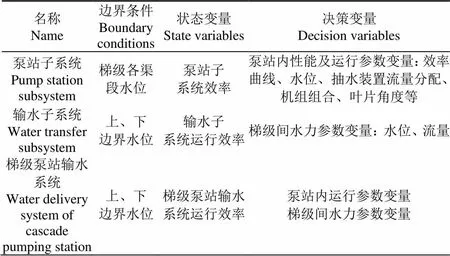
表1 串并联梯级泵站输水系统变量分析
1.3 串并联梯级泵站输水系统影响因素定量计算
基于上述时空分解理论,可对一定时段内的泵站效率、水力和水量损失等影响因素进行定量计算。其中,平衡时段内水力损失、泵站效率等参数可直接取时段均值。对于水量损失,由于梯级水量损失包括渗漏、蒸发、支流回水等,难以用公式表示,可根据时段内的损失总量[13],换算为单位输水长度上的瞬时损失流量。时段划分可根据渠段水量损失特性划分,一般可划分为输水初期、中期和后期3个阶段。
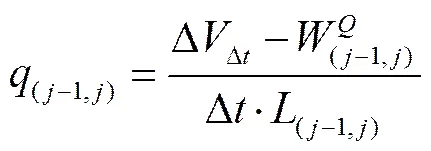
式中(j−1, j)为时段Dt内,第(−1)和级泵站间,单位长度渠道上的流量损失值,m3/s;DDt为第(−1)和级泵站间渠道在输水时段D内的蓄量变化值,m3;W(j−1,j)为由于第(−1)和级泵站流量差引起的渠道蓄量变化值,m3;(j−1,j)为第(−1)和级泵站间渠道长度,km。
综上,针对串并联梯级泵站输水系统运行效率计算存在的复杂性和动态性难题,通过空间上的系统分解和时间上平衡状态划分,定量计算泵站性能、水力、水量损失等参数,构建了基于时空分解的串并联梯级泵站输水系统运行效率的理论基础。
2 串并联梯级泵站输水系统运行效率表达式
在基于时空分解的串并联梯级泵站输水系统运行效率计算方法基础上,分别提出泵站子系统和输水子系统效率的定义和表达式,在此基础上将两者关联,依次提出串联、并联梯级泵站输水系统运行效率定义及表达式。
2.1 泵站子系统效率表达式
泵站子系统效率是反映各级泵站运行状态的综合指标。泵站子系统效率可定义为水体经各级泵站提升后,所获得的能量之和与各级泵站所消耗能量之和的比值。在单机组、单级泵站效率计算的基础上,综合各泵站的效率,给出泵站子系统效率ps表达式
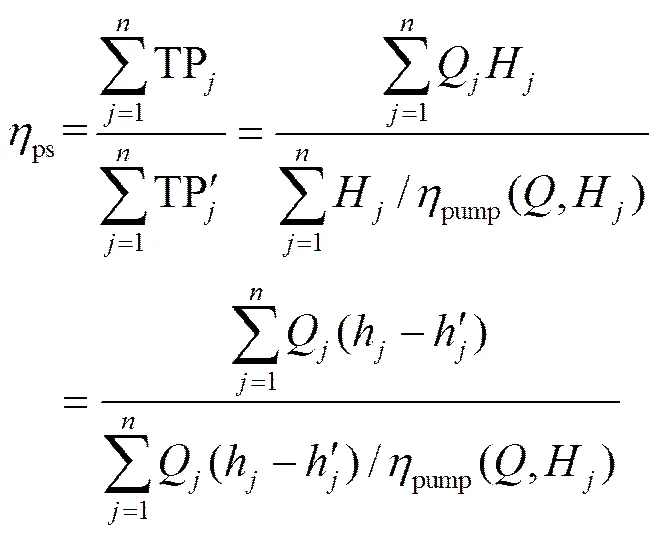
(3)
(4)
式中ps为泵站子系统效率;Q为第级泵站流量,m3/s;为水的密度,kg/m3;为重力加速度,m/s2;为梯级泵站个数;为泵站内机组的个数;TP为水体经过第级泵站提升所获得的能量,kW;TP′为第级泵站提水所需消耗的能量,kW;h′、h分别为第级泵站进、出水池水位,m;H为第级泵站的扬程,m,;为泵站流量为Q、扬程为H工况下,第级泵站内各抽水装置联合运行的效率值,即单级泵站效率;为泵站内抽水装置编号;为泵站内第个抽水装置的流量,当扬程H一定时,其为水泵叶片安放角θ、机组转速n的函数;为第个抽水装置的有效输出功率;为第个抽水装置的输入功率;set,i为第个抽水装置的效率,本文将泵站进、出水池的效率并入输水子系统效率中;为水泵装置效率,可通过装置模型数据换算或实际运行测试得出[14-15],为传动效率,为电机效率。
2.2 输水子系统效率表达式
输水子系统效率是反映梯级间渠道、拦污栅、闸门等整体输水状态的指标。输水子系统效率定义为水体经泵站提升后,经过级间渠道、拦污栅、闸门等设备、设施输送到目的地,最终获得的净能量与水体经过各级泵站提水获得的总能量的比值。水力、水量损失可理解为泵站能量损失的延伸,是影响输水子系统效率的主要因素。根据是否考虑级间水力、水量损失,级间是否有分水任务,可分为3种情况。
1)计入级间水力损失,级间无分水情况。仅计入水力损失,不考虑输水水量损失,且级间无分水任务情况下,系统末级泵站输出水体的净能量即系统最终获得的净能量,输水子系统效率cs表达式为

(6)
式中cs为输水子系统效率;TP为水体经过泵站、渠道(管道)输送到目的地(末级泵站出口)最终获得的净能量,kW;H为最末级泵站输出水体获得的有效扬程,即梯级间净扬程;为第和(+1)级泵站间渠道的水力损失,主要与级间流量、泵站进、出水池水位、糙率等因素相关,无实测资料时,可采用水力学模型进行预测。
2)考虑级间水力及水量损失,级间无分水情况。考虑级间水力及水量损失,级间无分水情况下,扣除级间流量损失,末级泵站输出水体的净能量即为系统最终获得的净能量,输水子系统效率cs表达式为
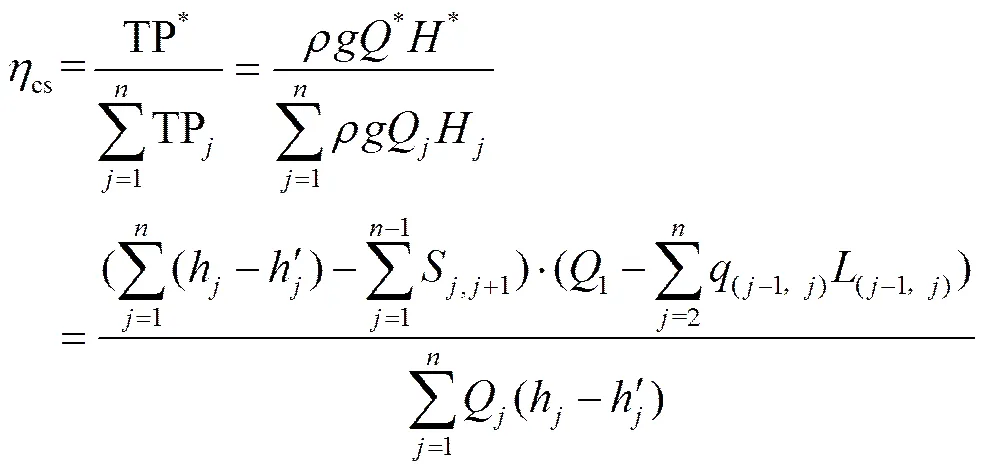
(8)
式中1为首级泵站的输出流量,m3/s;Q为最末级泵站所输出的流量,等于首级泵站的流量减去级间的水量损失,m3/s,见式(8);(j-1,j)为第(−1)和泵站间渠道长度,m;(j-1, j)为第(−1)和泵站间,单位长度渠道的流量损失值,m3/(s·m);Q为经过第级泵站的流量,数值上等于首级泵站减去第1级至级间的流量损失,m3/s,。
3)考虑级间水力、水量损失,级间分水情况。考虑级间水力、水量损失,级间有分水情况下,系统最终输出水体的净能量包括2部分:一部分为末级泵站输出水体获得的净能量;另一部分为沿线分水口输出水体获得的净能量。输水子系统效率cs表达式为

(10)
(11)
式中H为最末级泵站输出水体获得的有效扬程,m;Q为最末级泵站所输出的流量,m3/s,等于首级泵站流量减去沿线水量损失和分水流量,见式(10);z为第(−1)和泵站间的分水口总个数;k为第(−1)和泵站间分水口序号;为第(−1)和泵站间,第k个分水口的分水流量,m3/s;、分别为第k个分水口的高程、分水获得的净扬程,m;;Q为第级泵站的输出流量,m3/s,等于首级泵站流量减去第级泵站前所有流量损失和分水流量,见式(11)。
2.3 串联梯级泵站输水系统运行效率表达式
串联梯级泵站输水系统运行效率可定义为在串联线路上,水体经过多级泵站(泵站子系统)提升和渠道(输水子系统)传输,到达目的地后所获得的净能量与各级泵站消耗总能量的比值,等于泵站子系统效率与输水子系统效率的乘积。根据输水子系统效率的3种不同表达式,串联梯级泵站输水系统运行效率pcs的表达式分别为
1)计入级间水力损失,沿线无分水情况

2)计入级间水力及水量损失,级间无分水情况
(13)
3)计入级间水力、水量损失,级间有分水情况

式中pcs为串联梯级泵站输水系统运行效率。
2.4 并联梯级泵站输水系统运行效率表达式
并联梯级泵站输水系统运行效率定义为:水体经过各串联线路,到达目的地后获得的净能量与各串联梯级泵站输水系统内各级泵站消耗总能量的比值。假定并联梯级泵站输水系统包含条串联线路,根据是否计入级间水力、水量损失,级间是否有分水任务,3种工况下并联梯级泵站输水系统运行效率表达式分别见式(15)、(16)、(17)。当=1时,则等同于串联梯级泵站输水系统运行效率公式。
1)计入级间水力损失,沿线无分水情况

2)计入级间水力及水量损失,级间无分水情况
(16)
3)计入级间水力、水量损失,级间有分水情况

式中bpcs为并联梯级泵站输水系统运行效率;为串联线路序号;为串联线路总数。由此可得,串并联梯级泵站输水系统运行效率均可转化为以梯级间流量,各级泵站进、出水池水位,各级泵站效率为变量的函数,在此基础上可建立相应的优化模型[16-23],采用动态规划、粒子群等方法求解[24-28]。
3 典型并联梯级泵站输水系统运行效率计算实例及分析
3.1 典型并联梯级泵站输水系统
以典型并联梯级泵站输水系统为研究对象,该系统上、下游边界均为调蓄湖泊(S1、S2),系统包括3个梯级,6座低扬程、大流量的泵站,从上游至下游依次为A、A1,B、B1,C、C1;6段输水河道S1-A、S1-A1,A-B、A1-B1,B-C、B1-C1。可分为2个串联梯级泵站输水系统,其中串联系统1为S1-A-B-C(S2)、串联系统2为S1-A1-B1-C1(S2),2个串联系统设计输水流量分别为100、200 m3/s,见图4。
根据典型并联梯级泵站输水系统2016年1月-6月调度数据,将整个调度过程可划分为个平衡状态,从中选取1月18日-1月28日、5月6日-5月12日和6月14日-6月20日 3个典型时段平衡状态,在此基础上分别计算各子系统效率和系统整体运行效率。
3.2 泵站子系统运行效率计算及分析
基于实测运行数据,根据式(2)、(3)、(4),分别计算平衡状态1~3各级泵站抽水装置效率、泵站子系统效率。以串联系统1为例,泵站子系统效率计算结果见表2,基本结论如下:泵站子系统效率与各泵站抽水装置效率正相关,泵站抽水装置效率取决于各机组性能参数及流量、扬程组合。以平衡状态1、3为例,两者梯级净扬程分别为7.10和7.30 m,单机组流量基本相同,但两者运行效率分别为69%、74%,原因在于后者的各级泵站效率分布更为均衡。
3.3 输水子系统效率计算及分析
根据式(7)计算输水子系统效率,以串联系统1为例,输水子系统效率计算结果见表3,基本结论如下:1)输水子系统效率与沿线水力、水量损失负相关。如平衡状态2、3的水力损失分别为0.64、1.33 m,水量损失分别为5.92%、2.98%,输水子系统效率分别为89%、84%;2)水力损失主要包括河道、引水渠、拦污栅等的水力损失。正常工况下,水力损失随流量增加而增加。其中,平衡状态3,S1—A渠段水力损失较正常工况偏大,主要原因在于A泵站拦污栅有轻微堵塞现象。对于渠道水力损失预测,可构建渠道水力学模型[28-29],建立水力损失与上游水位、流量的相关关系;对冰期、拦污栅堵塞[30]等工况下水力损失需要进行单独处理;3)水量(渗漏、蒸发)损失与水位、天气、地下水等因素相关。可结合长期输水规律,根据式(1),分时段计算S1-A、A-B、B-C(S2)各渠段水量损失,并换算为瞬时损失流量或比率。

表2 泵站子系统效率计算结果
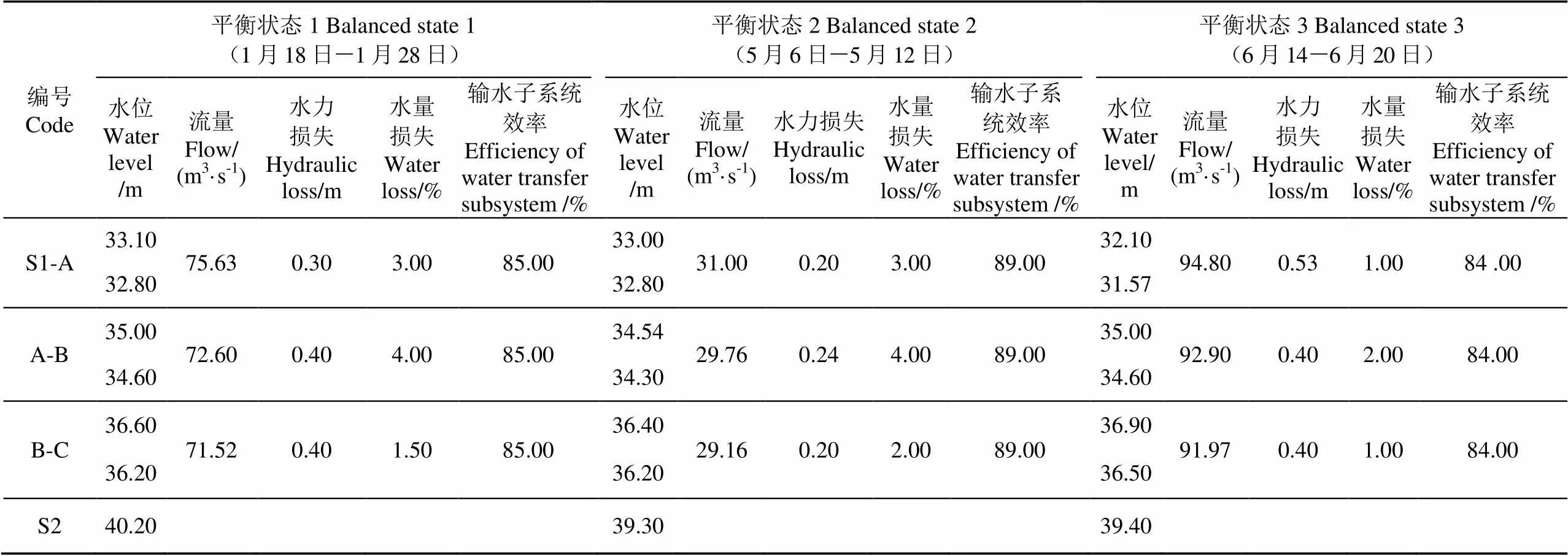
表3 输水子系统效率计算结果
3.4 串联梯级泵站输水系统运行效率计算及分析
根据式(13),可计算各串联梯级泵站输水系统运行效率,以串联系统1为例,串联梯级泵站输水系统运行效率计算结果见表4,基本结论如下:1)一定梯级净扬程情况下,串联梯级泵站输水系统运行效率取决于泵站、输水子系统效率组合。2)不同平衡状态下,系统运行效率区间为58.65%~62.16%。泵站子系统是系统优化的核心,但不能忽视特殊工况下输水子系统效率的影响。
3.5 并联梯级泵站输水系统运行效率计算及分析
根据式(16),可计算并联梯级泵站输水系统运行效率,并联梯级泵站输水系统运行效率计算结果见表5。基本结论如下:1)同一平衡状态下,不同串联系统运行效率有一定差异。平衡状态1下串联系统1和2运行效率分别为58.65%、54.62%;2)不同平衡状态下,并联系统效率区间为56.36~60.63%,尚有较大的优化空间。2)梯级净扬程和总输水流量一定情况下,并联梯级泵站输水系统运行效率取决于不同串联系统运行效率组合,以及对应的输水流量分配。3)可根据不同串联系统效率特性,制定流量优化分配方案,以提高并联系统运行效率。

表4 串联梯级泵站输水系统运行效率计算结果

表5 并联梯级泵站输水系统运行效率计算结果
4 结论与讨论
1)针对串并联梯级泵站输水系统运行中存在的复杂性和动态性,难以对其效率定量评价难题,本文提出了一套串并联梯级泵站输水系统实时运行效率计算方法,该方法通过调度系统在时间和空间上的分解,基于能量传输、转化原理,将系统中水力、水量损失等变量进行归一化处理,依次建立泵站、输水子系统和串、并联系统实时运行效率表达式,可对各子系统和整体实时运行效率进行计算。
2)该方法在典型并联梯级泵站系统的应用表明,与传统单一泵站效率和完成效率计算方法相比,该方法在效率计算的实时性和全面性上有明显提升。一方面,该方法可计算系统实时运行效率值,有利于发现影响系统运行效率的薄弱环节。另一方面,该方法不仅能够直观反映系统中各级泵站实时运行情况,还可定量评估各输水渠道以及系统整体运行情况,为实时调度提供了有利支撑。
本文建立的串并联梯级泵站输水系统运行效率计算方法为系统的优化提供了参考,考虑一定约束条件,可建立运行效率优化模型,求解优化运行方案。其中梯级水位、流量是2个核心优化变量,优化包含单变量和双变量2个层次的优化。单变量优化即水位(扬程)优化:在一定流量和梯级净扬程下,寻求一个优化水位分配,使系统运行效率最优;双变量优化即水位优化下的流量优化:一定梯级净扬程下,寻求一个最适宜流量值以及对应的梯级水位最优组合,使系统运行效率全局最优。
[1] 桑国庆,曹升乐,郭瑞,等. 基于分时电价的梯级泵站输水系统日优化运行[J]. 排灌机械工程学报,2013,31(8):688-695.
Sang Guoqing, Cao Shengle, Guo Rui, et al. Optimization of cost per day of cascade pumping station water-delivery system[J]. Journal of irrigation and drainage engineering, 2013, 31(8): 688-695. (in Chinese with English abstract)
[2] 冯晓莉,仇宝云. 考虑河道输水损失的大型泵站系统运行优化[J]. 农业工程学报,2015,31(17):35-41.
Feng Xiaoli, Qiu Baoyun. Optimal operation for large pumping station system based on water transferring losses of river[J]. Transactions of the Chinese Society of Agricultural Engineering (Transactions of the CSAE), 2015, 31(17): 35-41. (in Chinese with English abstract)
[3] 冯晓莉,仇宝云,杨兴丽,等. 大型泵站运行优化方法及其应用[J]. 排灌机械工程学报,2011,29(2):127-132.
Feng Xiaoli, Qiu Baoyun, Yang Xingli, et al. Optimal methods and its application of large pumping station operation[J]. Journal of Drainage and Irrigation Machinery Engineering, 2011, 29(2): 127-132. (in Chinese with English abstract)
[4] 冯晓莉,仇宝云,王斐,等. 南水北调东线高港泵站优化运行方案研究[J]. 水利学报,2010,41(4):412-418.
Feng Xiaoli, Qiu Baoyun, Wang Fei, et al. Study on optimal operation schemes of Gao gang pumping station in eastern route of south-to-north water transfer project[J]. Journal of Hydraulic Engineering, 2010, 41(4): 412-418. (in Chinese with English abstract)
[5] 冯晓莉,仇宝云. 大型泵站系统运行优化模型与节能效果比较[J]. 农业工程学报,2012,28(23):46-51.
Feng Xiaoli, Qiu Baoyun. Optimal operation models and comparison of their energy-saving effects for large pumping station system[J]. Transactions of the Chinese Society of Agricultural Engineering (Transactions of the CSAE), 2012, 28(23): 46-51. (in Chinese with English abstract)
[6] 曹鸣,姚青云. 梯级泵站优化调度研究进展[J]. 宁夏农学院学报,2003,24(4):101-106.
Cao Ming, Yao Qingyun. Progress of studies on optimization operation for multi stage pumping station[J]. Journal of Ningxia Agricultural College, 2003, 24(4): 101-106. (in Chinese with English abstract)
[7] 黄海田,仇宝云,王斐. 泵站+渠道构成的站渠系统调水效率概念的建立与计算[J]. 灌溉排水学报,2007,26(4B):16-17.
Huang Haitian, Qiu Baoyun, Wang Fei. The establishment and calculation of pumping station-canal system water transfer efficiency concept[J].Journal of Irrigation and Drainage, 2007, 26(4B): 16-17. (in Chinese with English abstract)
[8] 黄海田,仇宝云,马倩,等. 基于系统理念对东线江苏境内一期工程进行调水效率研究的设想[J]. 南水北调与水利科技,2007,5(2):3-5.
Huang Haitian, Qiu Baoyun, Ma Qian, et al. Preview on water diversion efficiency research in the first phase of the eastern route of south to north water diversion project in Jiangsu province based on system conception[J]. South to North Water Transfers and Water Science & Technology, 2007, 5(2): 3-5. (in Chinese with English abstract)
[9] 黄海田,仇宝云,颜红勤,等. 多级调水-供水-蓄水结合泵站-渠道-湖库系统效率计算[J]. 水利水运工程学报,2007(4):21-26. Huang Haitian, Qiu Baoyun, Yan Hongqin, et al. Efficiency computation of multi-stage pumping station-canal-lake reservoir system for water transfer-supply-storage[J]. Hydro-Science and Engineering, 2007(4): 21-26. (in Chinese with English abstract)
[10] 郑世宗,贾宏伟,崔远来. 区分工程状况与管理水平影响的渠系水利用效率指标体系的构建[J]. 农业工程学报,2013,29(18):1-7.
Zheng Shizong, Jia Hongwei, Cui Yuanlai. Structure of assessment indicator system of water use efficiency for distinguishing engineering conditions and management level of canal-system[J]. Transactions of the Chinese Society of Agricultural Engineering (Transactions of the CSAE), 2013, 29(18): 1-7. (in Chinese with English abstract)
[11] 崔远来,谭芳,郑传举,等. 不同环节灌溉用水效率及节水潜力分析[J]. 水科学进展,2010,21(6):787-793.
Cui Yuanlai, Tan Fang, Zheng Chuanju, et a1. Analysis of irrigation efficiency and water saving potential at different scales[J]. Advances in Water Science, 2010, 21(6): 787-793. (in Chinese with English abstract)
[12] 桑国庆,曹升乐,郭瑞,等. 梯级泵站输水系统运行效率优化模型[J]. 系统工程理论与实践,2014,34(8):2179-2185.
Sang Guoqing, Cao Shengle, Guo Rui, et al. Research on optimization of whole efficiency of cascade pumping station water-delivery system[J]. Systems Engineering Theory & Practice, 2014, 34(8): 2179-2185. (in Chinese with English abstract)
[13] 胡周汉,方国华,马兆龙,等. 南水北调东线一期输水工程水量损失计算方法及应用[J]. 水电能源科学,2016,34(8):45-49.
Hu Zhouhan, Fang Guohua, Ma Zhaolong, et al. Calculation and application of water losses in the first-phase in east route of south-to-north water diversion project[J]. Water Resources and Power, 2016, 34(8): 45-49. (in Chinese with English abstract)
[14] 严登丰. 泵与泵装置特性预测[J]. 排灌机械工程学报,2012,30(3):315-323.
Yan Dengfeng. Performance prediction for pump and pumping system[J]. Journal of Drainage and Irrigation Machinery Engineering, 2012, 30(3): 315-323. (in Chinese with English abstract)
[15] 龙新平,朱劲木,刘梅清,等. 基于性能曲面拟合的泵站优化调度分析[J]. 水利学报,2004,35(11):27-31.
Long Xinping, Zhu Jinmu, Liu Meiqing, et al. Optimized dispatch of pumping stations based on performance curve surface fitting[J]. Journal of Hydraulic Engineering, 2004, 35(11): 27-31. (in Chinese with English abstract)
[16] 程吉林,张礼华,张仁田,等. 泵站叶片可调单机组日运行优化方法研究[J]. 水利学报,2010,41(4):499-504.
Cheng Jilin, Zhang Lihua, Zhang Rentian, et al. Study on optimal daily operation of single adjustable-blade pump unit in pumping station[J]. Journal of Hydraulic Engineering,2010, 41(4): 499-504. (in Chinese with English abstract)
[17] 周龙才. 长渠道梯级供水泵站变频转速最优匹配[J]. 武汉大学学报,2010,43(5):576-580.
Zhou Longcai. Optimal matching of cascade water supply pumping stations with long channels by variable frequency speed control[J]. Engineering Journal of Wuhan University,2010, 43(5): 576-580. (in Chinese with English abstract)
[18] 龚懿,程吉林,张仁田. 淮安-淮阴段梯级泵站群运行优化[J]. 农业工程学报,2013,29(22):59-67.
Gong Yi, Cheng Jilin, Zhang Rentian. Operation optimization of Huai’an-Huaiyin multistage pumping stations[J]. Transactions of the Chinese Society of Agricultural Engineering (Transactions of the CSAE), 2013, 29(22): 59-67. (in Chinese with English abstract)
[19] Mariño M A, Moradi-Jalal M, Afshar A. Optimal design and operation of irrigation pumping stations[J]. Journal of Irrigation and Drainage Engineering, 2003, 129(3): 149-154.
[20] Vieira F, Ramos H M. Optimization of operational planning for wind/hydro hybrid water supply systems[J]. Renewable Energy, 2009, 34(3): 928-936.
[21] 张礼华. 南水北调提水泵站站内优化运行模式研究[D]. 扬州:扬州大学,2007.
Zhang Lihua. Study on Optimal Function of the Lift Pump Stations in the South-to-North Water Transfer Project[D]. Yangzhou: Yangzhou University, 2007. (in Chinese with English abstract)
[22] 专祥涛,李明龙. 基于移峰填谷的排水泵站优化调度研究[J]. 武汉大学学报工学版,2011,44(6):773-778.
Zhuan Xiangtao, Li Minglong. Optimal operation of pumping stations with load shifting[J]. Engineering Journal of University, 2011, 44(6): 773-778. (in Chinese with English abstract)
[23] 梁兴,刘梅清,刘志勇,等. 基于混合粒子群算法的梯级泵站优化调度[J]. 武汉大学学报工学版,2013,46(4):536-539.
Liang Xing, Liu Meiqing, Liu Zhiyong, et al. Optimum dispatching of multistage pumping station based on mixed particle swarm optimization[J]. Engineering Journal of Wuhan University, 2013, 46(4): 536-539. (in Chinese with English abstract)
[24] 龚懿,程吉林,刘静森. 扬程-水位逐次逼近策略优化梯级泵站群级间河道水位[J]. 农业工程学报,2014,30(22):120-129.
Gong Yi, Cheng Jilin, Liu Jingsen. Water level optimization of water transferring channel in multi-stage pumping stations based on head-water level successive approximation optimization method[J]. Transactions of the Chinese Society of Agricultural Engineering (Transactions of the CSAE), 2014, 30(22): 120-129. (in Chinese with English abstract)
[25] 陈晓楠,段春青,邱林,等. 基于粒子群的大系统优化模型在灌区水资源优化配置中应用[J]. 农业工程学报,2008,24(3):103-106.
Chen Xiaonan, Duan Chunqing, Qiu Lin, et al. Application of large scale system model based on particle swarm optimization to optimal allocation of water resources in irrigation areas[J]. Transactions of the Chinese Society of Agricultural Engineering (Transactions of the CSAE), 2008, 24(3): 103-106. (in Chinese with English abstract)
[26] 龚懿,程吉林,张仁田,等. 淮阴三站变频变速优化运行的分解-动态规划聚合法[J]. 农业工程学报,2011,27(3):79-83.
Gong Yi, Cheng Jilin, Zhang Rentian, et al. Optimization on variable speed operation with VFD for No.3 Huaiyin pumping station based on decomposition-dynamic programming aggregation method[J]. Transactions of the Chinese Society of Agricultural Engineering (Transactions of the CSAE), 2011, 27(3): 79-83. (in Chinese with English abstract)
[27] 张礼华,程吉林,张仁田,等. 基于试验-整数规划方法的泵站多机组变速优化[J]. 农业工程学报,2011,27(5):156-159.
Zhang Lihua, Cheng Jilin, Zhang Rentian, et al. Research on optimal operation for multi-units with variable speed in one pumping station based on the theory of experimental and integer programming method[J]. Transactions of the Chinese Society of Agricultural Engineering (Transactions of the CSAE), 2011, 27(5): 156-159. (in Chinese with English abstract)
[28] 马吉明,史哲. 南水北调典型宽浅渠道糙率系数研究[J]. 水力发电学报,2007,26(5):75-79.
Ma Jiming, Shi Zhe. Research on the absolute roughness of the typical channel of the south-to-north water diversion project[J]. Journal of Hydroelectric Engineering, 2007, 26(5): 75-79. (in Chinese with English abstract)
[29] 黄会勇,刘子慧,范杰,等. 南水北调中线工程总干渠水力学仿真模型研究[J]. 水利水电技术,2013,44(12):111-115. Huang Huiyong, Liu Zihui, Fan Jie, et al. Study on hydraulic simulation model of main canal of Mid-route of South-to-North Water Transfer Project[J]. Water Resources and Hydropower Engineering, 2013, 44(12): 111-115. (in Chinese with English abstract)
[30] 贺淑全. 拦污栅拦污流动数值模拟与阻力预测[D]. 扬州:扬州大学,2013.
He Shuquan. Numerical Simulation of Trash-barriering Flow of Rack and Prediction of Trash-barriering Resistance[D]. Yangzhou: Yangzhou University, 2013. (in Chinese with English abstract)
Calculation method and application on operation efficiency of water transfer system with cascade pumping station based on time and space scale
Sang Guoqing1,2, Zhang Shuanghu2, Zhang Lin3, Song Shuxin1
(1.250061; 2.100038; 3.250012,)
Water resource is distributed unevenly in time and space in the world. With the development of society, water demand is increasing. In some places, water shortage is becoming the bottleneck of the development of social economy. In order to realize the rational allocation of water resources, lots of water diversion projects with cascade pumping stations have been carried out. Water is transferred from areas with plenty of water to areas with more water demand. For example, South-to-North Water Transfer Project is being built in China, which is the largest water transfer project in the world. There are 3 lines for this project, which are East line, Middle line and West line. East line is typical parallel and series cascade pump system, which is the largest pumping station system in the world. Water is pumped from Yangzi River in Yangzhou of Jiangsu Province to North areas including Jiangsu and Shandong Province. At some places old rivers are used for water transfer such as the Grand Canal between Beijing and Hangzhou. At other places new channels are built for water transfer. Some lakes used for storage are connected by these channels and rivers such as Hongze Lake, Nansi Lake and Dongping Lake. From Dongping Lake water flow becomes gravity flow to 2 directions. One route is north to Tianjin finally and the other is east to Jiaodong area. Water transferred to Jiaodong belongs to the first stage. Now the first stage of East line has been finished and is on operation period. It is typical cascade pumping station system for water transfer project. Large scale pumping station in parallel and series is a complex water transfer system. It consists of water pumps, controlling gates, channels or pipes and water lakes or reservoirs, and so on. Water is pumped from low area to high position or pressure pipes. Then it is transferred by channels or pressure pipes to water lakes or reservoirs. Lakes and reservoirs are used for storage and volume adjusting. In this system, pumping stations at different levels are control units. Channels or pipes between pumping station units limit the adjusting ability on water quantity. What’s more, discharge and water level interrelate. During the operation period, water flow is changing dynamically caused by different scenarios or unknown external disturbance. So this system has the characteristics of complexity and dynamic. It is difficult to evaluate and optimize the real-time operation state. So how to control the system accurately becomes a challenge. Normally operation efficiency is one of the important methods for checking the validity. The operation efficiency of cascade pumping stations for water transfer system reflects the operating results of the whole system. It determines the energy consumption and the cost of water transfer. So it is an important evaluation index of system operation. It can also be one of the criteria to measure the success of water transfer project. There are many methods which can be used to calculate out operation efficiency. But these methods are focusing on end efficiency or average efficiency, which cann’t reflect the accurate system running status in real time or a time interval. In order to solve these problems, with a series of research or experiments, the operation efficiency theory based on time and space is presented. In space scale, this system is divided into several subsystems, which are parallel subsystem, series subsystem, pumping station subsystem and water transfer subsystem.Pumping station subsystem consists of different pumping stations at different levels, which is the center of energy transfer of the whole system. Water transfer subsystem consists of different hydraulic structures such as channels, pipes, trash rack, and so on, which is the link of energy transfer. Different subsystems are connected by hydraulic factors such as water level or discharge. The operation efficiency of the whole system is decided by different subsystem. In time scale, it is divided into several parallel states, which are used to calculate pumping station performance, hydraulics loss and water quantity loss. A series of index system and formulas for operation efficiency of large scale pumping station are given out including pumping station subsystem and water transfer subsystem. Based on this, the related influence factors are studied with quantitative analysis. This research provides the theoretical basis for optimizing the operation efficiency of large scale pumping station system. Based on real operation datain 2016 of typical water transfer system with cascade pumping station in parallel, practice is carried out for this theory. Results show that this method can evaluate the operational efficiency accurately and find out the optimized potential factors and bottlenecks of the subsystems and the whole system. The operation efficiency of cascade pumping station system based on time and space scale is decided by different related factors such as water level, discharge and pumping unit power, and so on. So it is necessary to monitor these factors accurately. At the same time, summaries should be made in time about pumping station unit performance, hydraulics, discharge loss, and so on to find out the useful law. In one word, accurate operation efficiency comes from accurate raw data and detailed study. In addition, the operation efficiency can also provide the reference for route comparison and model selection of all-level pumping stations, and therefore, it can also be used for project planning.
pumps; optimization; efficiency; cascade pumping stations; water transfer system
10.11975/j.issn.1002-6819.2017.06.009
TV675
A
1002-6819(2017)-06-0067-09
2016-10-09
2017-01-15
国家科技支撑计划项目课题(2015BAB07B02);国家青年基金(51409119);山东省省级水利科研与技术推广项目(SDSLKY201404)
桑国庆,男,山东省济宁人,副教授,博士,主要从事梯级泵站优化调度、山洪灾害防治研究等。济南 济南大学资源与环境学院,250061。Email:sangguoqing@163.com

